Bridge tokens to Linea
The Linea bridge app provides multiple ways to get funds onto Linea:
- Native bridge: Built by our team to provide an interface for the canonical token bridge. Best suited for tech operators, protocols, or moving large liquidity, but also suitable for users that want to bridge ETH or ERC-20 tokens.
- All bridges: A bridge aggregator powered by Li.Fi, supporting numerous networks (EVM chains and Solana) and tokens. Faster than the native bridge, and the best option for most users.
- Buy: A fiat onramp aggregator provided by Onramper, enabling you to buy funds on Linea.
Testnet bridging is only possible on the native bridge.
See the below sections for instructions on each option.
Bridge aggregator
Find the bridge aggregator under the "All Bridges" tab. It's powered by Li.Fi and supports a range of chains and tokens. Available networks include most major EVM networks and L2s, plus Solana. The optimal bridging routes are automatically selected based on your priority (speed or price, configurable in settings), and use a combination of decentralized exchanges (DEXs) and bridges.
In many cases, transfers initiated using the bridge aggregator are much faster than those created with the native bridge, but cost slightly more. In some cases, particularly when bridging to Linea or bridging USDC, the native bridge is faster. See the section on bridging timescales for more information.
For a guide on using the bridge aggregator and FAQs, see our support guide.
Native bridge
Bridge ETH or other tokens
Head to the bridge app and select the "Native Bridge" tab.

- Select the direction of your transfer — either L1 → L2 or L2 → L1.
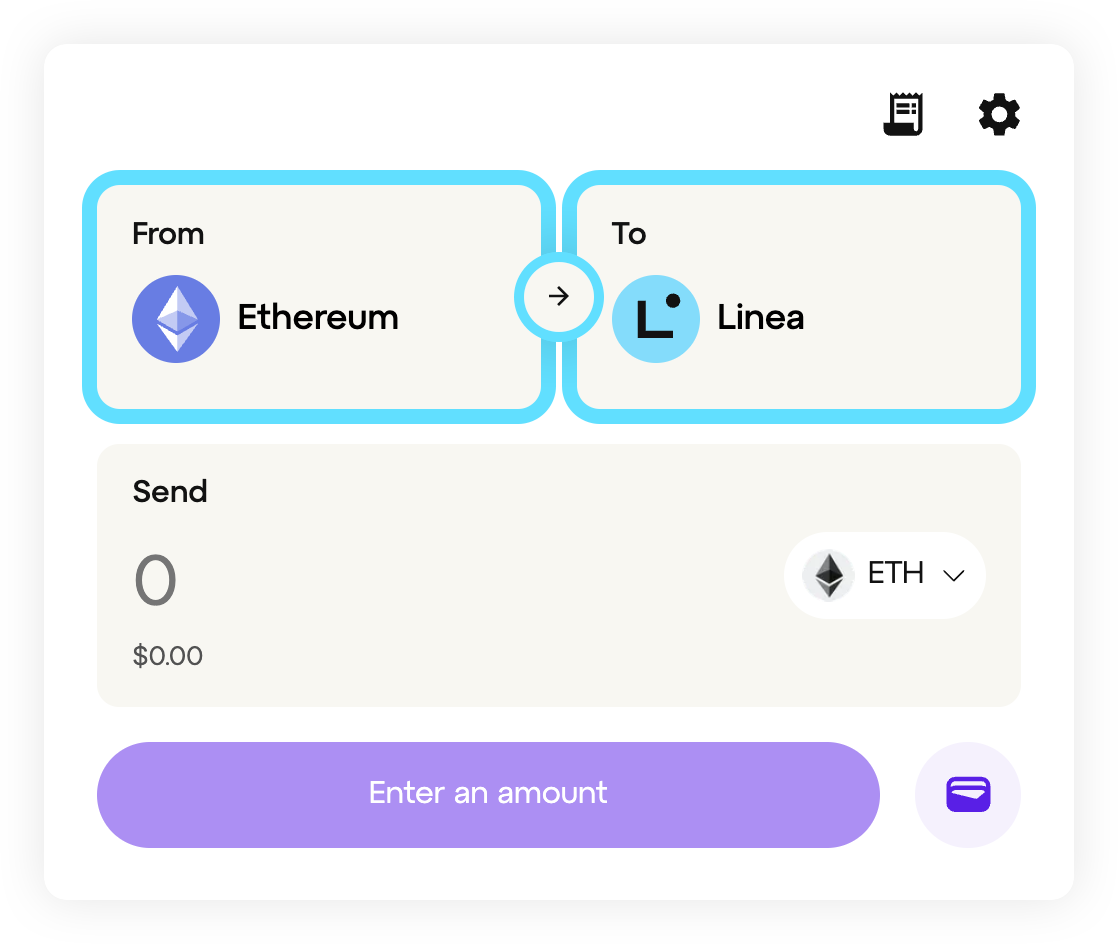
- Select the asset you'd like to bridge: ETH or an ERC-20 token. Available ERC-20 tokens are based on a shortlist we maintain here.
For some combinations of origin and destination chains and assets, you may need to submit an additional transaction on the destination network to claim your funds. This is manual claiming, and is required for any transfers:
- From Linea to Ethereum (L2 → L1)
- Involving USDC.
Automatic claiming is selected by default for all transfers where it is possible, and manual claiming is automatically applied when necessary. See below for more information.

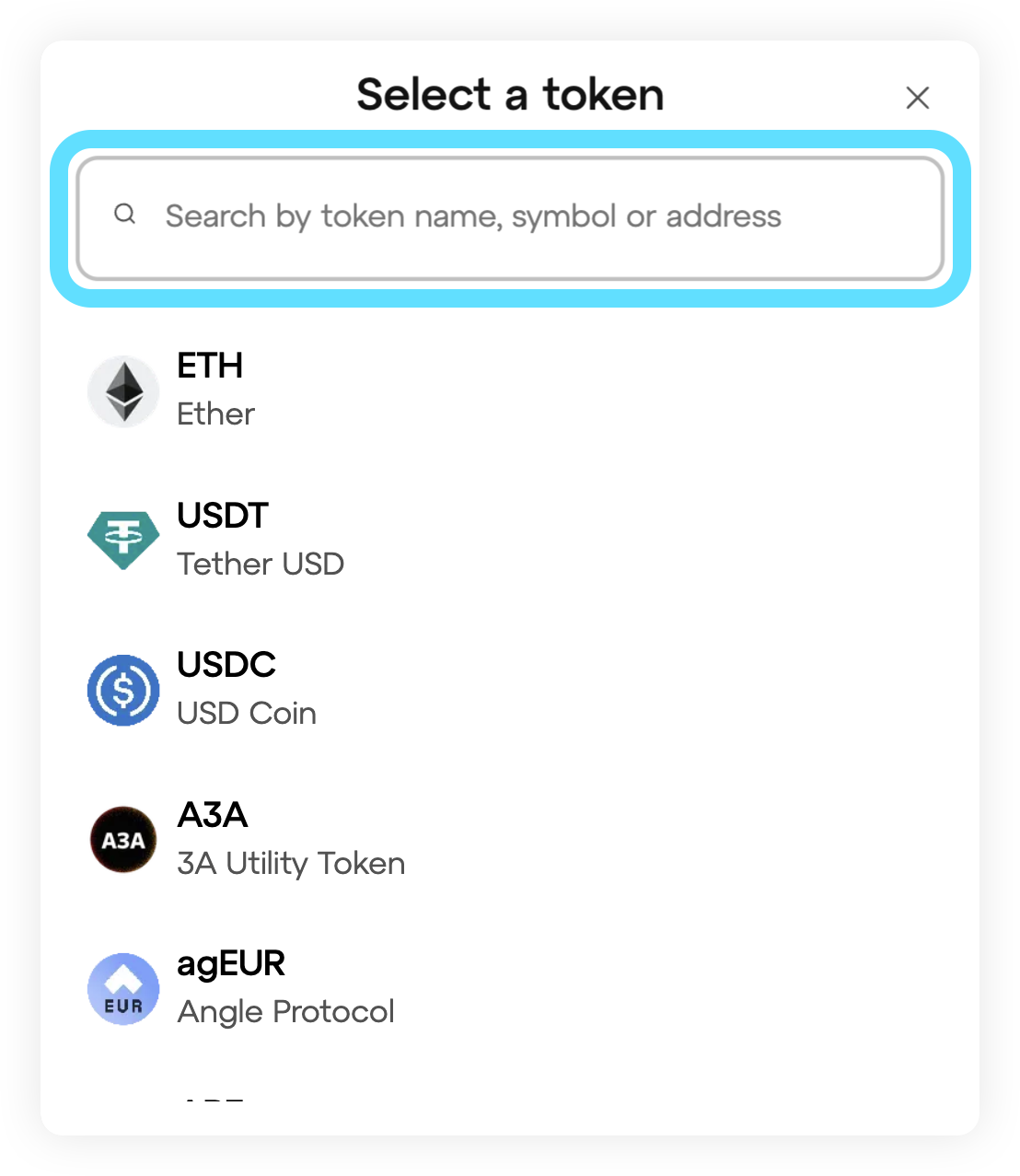
- Enter the amount you'd like to bridge.

- If needed, you can nominate a recipient address different to the origin address. To do so, click the wallet icon in the bottom-right of the widget and input the recipient address you need:
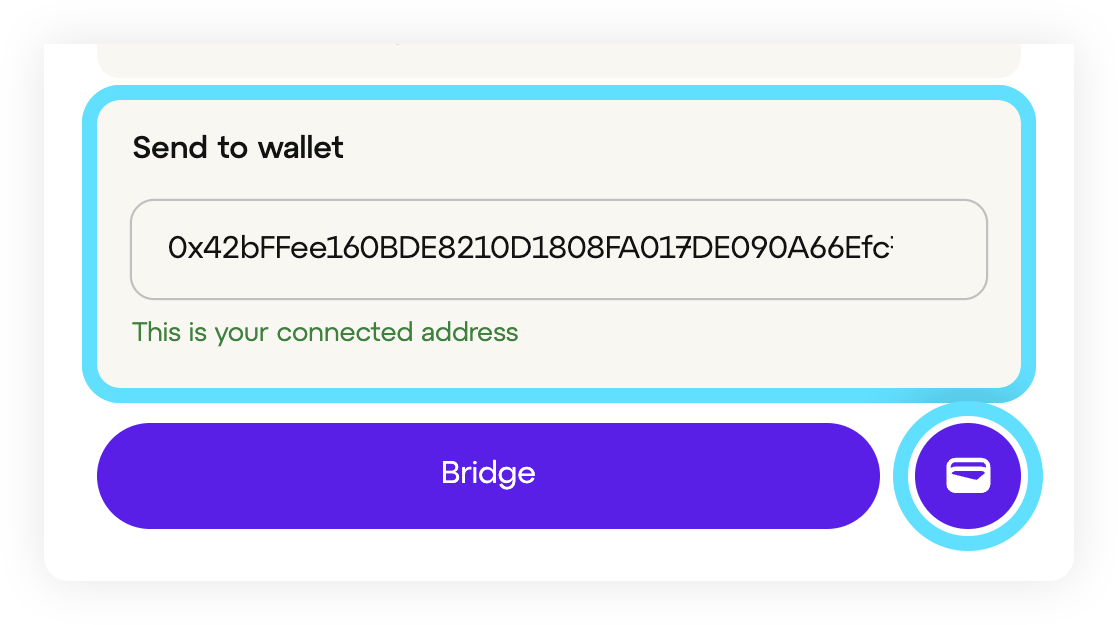
If you're bridging an ERC-20 token that you haven't bridged before, you'll need to complete an additional transaction at this point to approve a spending cap before you can bridge:

The spending cap enables the bridge app to access the funds you want to transfer.
- Click "Bridge", and then confirm the details and sign the transaction to proceed.

After the transaction is confirmed, your bridge transfer will be visible in your transaction history, accessible via the icon next to settings in the top-right of the widget.

Bridge USDC
USDC is handled differently by the native bridge. Since Linea has native USDC, the bridge uses the Cross-Chain Transfer Protocol (CCTP) rather than the canonical token bridge that underpins other native bridge transfers.
USDC transfers currently require manual claiming.
The native bridge supports both standard and fast transfers for USDC. Standard transfers are the default option for USDC bridging, though you can select a fast transfer by clicking the "CCTP Standard" button displayed in the bridge:
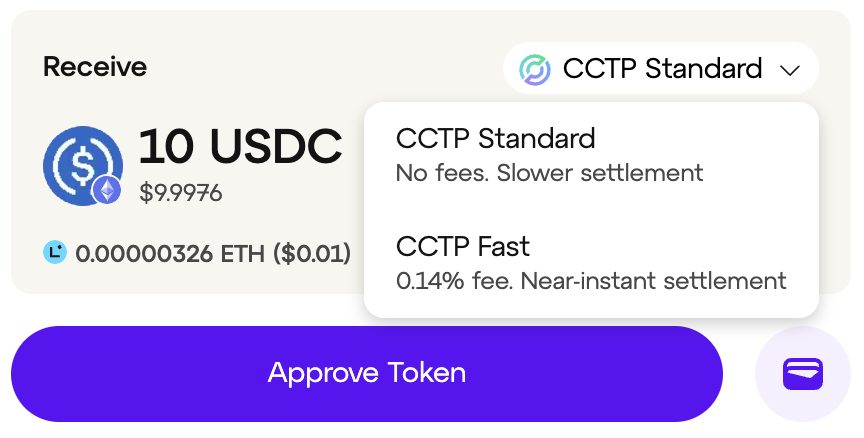
Refer to the table below for the expected duration of USDC transfers according to destination chain and transfer type:
| Direction | CCTP Standard | CCTP Fast |
|---|---|---|
| L1 → L2 | ~13-19 minutes | ~20 seconds |
| L2 → L1 | ~2-12 hours | ~8 seconds |
Claiming
The native bridge allows you to claim your bridged funds manually or automatically.
- Manual claiming requires two transactions to be approved. One on the source layer to initiate the bridging process and the other on the target layer by the recipient to receive the funds, which we call "claiming". To claim, the recipient has to pay a fee on the target layer.
- Automatic claiming requires one transaction to be approved on the source layer. The recipient will automatically receive their funds because a "postman" will handle the claiming process for them.
Manual claiming is required for any transfers:
- From Linea to Ethereum (L2 → L1)
- Involving USDC.
Manual claiming
If you have an unclaimed manual claim transaction that is older than 90 days, you'll need to claim it manually, as it will no longer be displayed in the native bridge app. See our message service reference page for guidance. This situation could arise, for example, because the postman failed for some reason, such as a network issue.
Go to the transaction history page by clicking the receipt icon in the top-right of the widget.

If your manual claim transaction is ready to claim, it will be marked as "Ready to claim":

When you click the transaction, you'll see its details and a "Claim" button — click it to prompt a transaction in your wallet:
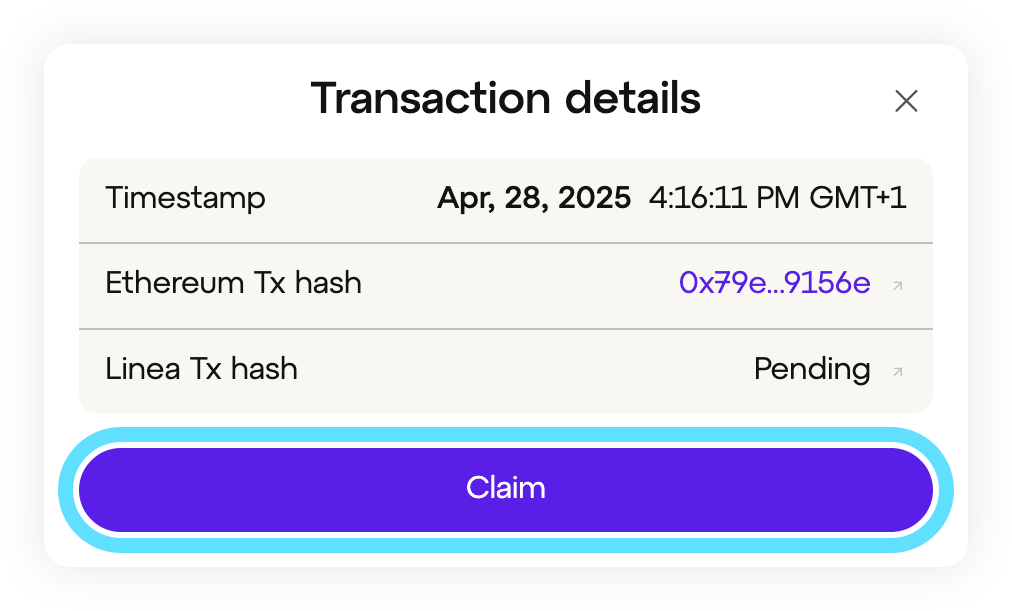
Once the transaction is complete, your funds will be available in your wallet and the transaction history will update accordingly:
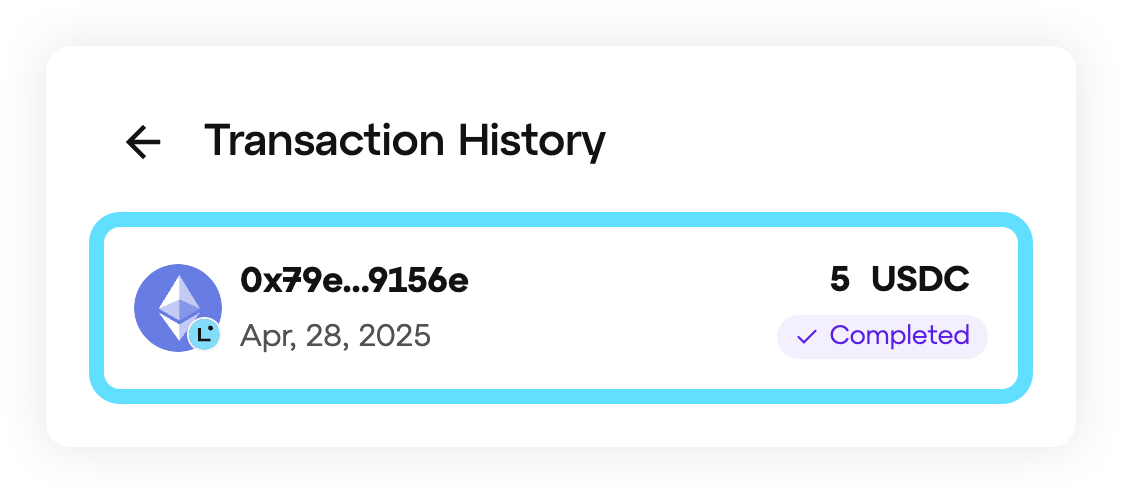
If you encounter any issues, contact us via our support site or Discord.
Configure claiming
Automatic claiming is the default option wherever possible, though for the following transfers, manual claiming is required:
- Linea to Ethereum (L2 → L1)
- Any transfer involving USDC.
Although manual claiming is mandatory depending on the context, you can toggle between manual and automatic claiming where applicable by clicking the gear icon in the "Receive" panel:
The manual claiming toggle will then be available:

Execution fees
The postman fee for L1 → L2 transfers (i.e. deposits to Linea) is now sponsored for all users for all transfers using less than 250,000 gas, covering the majority of bridging use cases.
This means that most automatic claiming transfers from L1 to L2 now have no fees, apart from a few cases outlined above. You will, however, still need to cover the costs of the L1 transaction.
The only fees you'll pay on the native bridge are those required to complete the transaction — other than network fees, the native bridge is fee-free and Linea does not profit from it.
Two types of execution fees can be applied when bridging with the native bridge: the postman fee and the anti-DDOS fee.
Refer to the table for which fees will apply to your bridge transfer. These fees apply to both ETH and ERC-20 transfers.
| Type | Transaction fee | Anti-DDOS fee | Postman fee |
|---|---|---|---|
| L1 to L2 (Manual claiming) | ✅ | ❌ | ❌ |
| L1 to L2 (Automatic claiming) | ✅ | ❌ | ❌ |
| L2 to L1 (Manual claiming) | ✅ | ✅ | ❌ |
Key:
-
Transaction fee: The transaction (gas) fee required for the bridge operation.
-
Anti-DDOS fee: A 0.001 ETH fee applied when bridging from L2 to L1.
-
Postman fee:
target layer gas price * (gas estimated + gas limit surplus) * margin, where:target layer gas price=eth_gasPriceon the target layergas estimated= 100,000gas limit surplus= 6000margin= 2
Previously the postman fee was applied to automatic claiming transfers from L1 to L2, but is now free.
How long do bridge transfers take?
For ETH or ERC-20 tokens:
- L2 → L1: ~2-12 hours
- L1 → L2: ~20 minutes
See the USDC section for more information on the expected duration of USDC transfers.
Centralized exchange (CEX)
Head to the Layerswap documentation for guides on transferring from CEXs.
An integration with Layerswap enables you to withdraw funds to Linea from one of several supported CEXs. This enables you to move funds from a CEX to Linea even if the CEX doesn't support Linea.
Generally, this process involves these steps:
- Configure your source CEX and transfer amount.
- Layerswap generates a unique deposit address.
- Go to the CEX and transfer the required funds to the deposit address.
- Layerswap handles the cross-chain transfer to Linea.
The process can differ slightly depending on the CEX. The Layerswap docs contain guides specific to each CEX.
Buy
Under the "Buy" tab, you'll find the Onramper widget, which enables you to buy funds on Linea using fiat currency.
For a guide on using Onramper, see their resources.
Onramper is an aggregator, and aims to select the best option for your payment method, location, and token.
KYC is required to use Onramper.
Onramp options may differ based on your location — check the Onramper coverage page to see what's available.
Custom options for moving large liquidity
Use the canonical token bridge with a custom BridgedToken implementation
This is suited for protocols that want to implement special features for the bridged ERC-20 on L2. This is only possible if the token has not yet been bridged from L1 to L2 in order to avoid unexpected changes for end-users.
Protocols that want to use a custom BridgedToken will be able to incorporate arbitrary logic on the L2 ERC-20, while still relying on the Token Bridge lock and mint logic and cross-chain communication. For this to work, protocols need to keep compatibility with the Token Bridge by enabling it to call the ERC-20 mint and burn functions.
If you are interested in this option, please contact the Linea team to get started. The process is as follows:
- The token issuer deploys a custom BridgedToken which should enable the Token Bridge to call mint and burn functions.
- Linea team will configure the bridge so that it will use your custom contract to mint and burn tokens on L2.
If you are not yet ready with your own implementation, you can deploy the standard BridgedToken implementation behind a dedicated upgradable proxy that you will be able to upgrade later
Build a dedicated token bridge
This is intended for partners who need full control over the bridge and want to implement complex cross-chain logic.
The partner will be in charge of building, auditing and operating their own token bridge.
If you are interested by this option, please get in touch with us so that we can:
- Block your L1 token from being bridged on L1 in order to avoid having several copies on Linea
- Provide guidance if you want to rely on our cross-chain messaging system